If you’ve poured everything into building a brand, the idea of someone selling cheap knockoffs of your products on Amazon is a nightmare. This is where Amazon brand gating comes in. It’s your frontline defense.
Brand gating puts a virtual lock on your brand’s listings. Any other seller who wants to sell your products has to get your explicit permission and prove they have legitimate, authentic inventory. Think of it as putting up an “authorized sellers only” sign on your digital storefront.
What is Amazon Brand Gating?
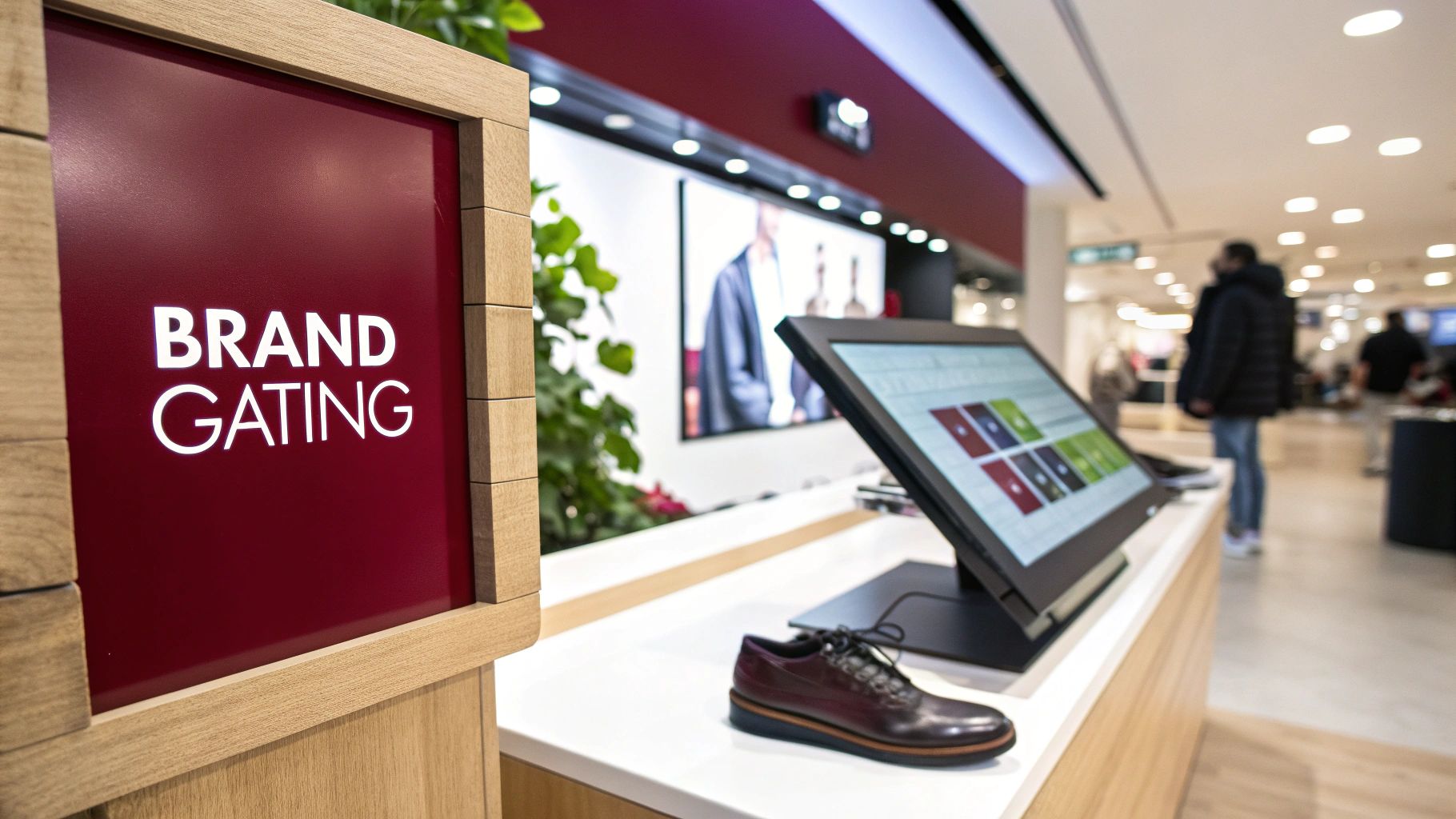
For brand owners, fighting counterfeiters and unauthorized resellers can feel like a constant, uphill battle. Amazon Brand Gating is one of the most effective tools Amazon provides to fight back.
When your brand is gated, Amazon requires other sellers to submit specific proof, like invoices from your authorized distributor or a direct letter of authorization from you, before they can list an offer on your ASINs. This stops unauthorized sellers cold.
Amazon brand gating helps protect your brand’s reputation, keep prices consistent, and ensure customers receive genuine products instead of counterfeits.
Gating vs. Other Restrictions
It’s easy to get “gating” mixed up with other Amazon restrictions. They sound similar but work differently. Knowing the difference is key to figuring out what you need.
Let’s break down the common types of restrictions.
Gating vs. Restrictions: A Quick Comparison
| Restriction Type | What It Controls | Who Initiates It | Typical Requirement |
|---|---|---|---|
| Brand Gating | Sales of specific branded products (e.g., all “Nike” shoes). | You, the brand owner, through Brand Registry. | Letter of Authorization or invoices from the brand. |
| Category Gating | Sales within an entire product category (e.g., Fine Jewelry). | Amazon, for quality and safety control. | Professional seller account, performance metrics, invoices. |
| ASIN Restrictions | Sales of a single, specific product (ASIN). | Amazon, due to safety, counterfeit, or policy issues. | Varies; could require invoices, safety certs, or be temporary. |
Brand Gating is unique because it’s a proactive shield you build around your intellectual property. The other restrictions are typically put in place by Amazon for broader marketplace safety.
The first step to qualify for brand gating is enrolling in Amazon’s Brand Registry, a program that gives you access to brand protection tools. We cover all the Amazon Brand Registry benefits in our detailed guide if you want to learn more.
What Gating Can and Cannot Do
While it’s a powerful tool, it’s important to have realistic expectations. Brand gating is a massive deterrent that stops most unauthorized sellers. It helps stabilize your pricing by preventing a race to the bottom and protects your brand’s reputation by ensuring customers receive genuine products.
However, the final decision to gate a brand or specific ASINs is always at Amazon’s discretion, and the protection isn’t guaranteed to be permanent. Some determined sellers might still try to find loopholes, like listing your products as “Used – Like New.”
Think of it as a critical layer of defense, not an impenetrable fortress. It makes unauthorized selling incredibly difficult, which is exactly the advantage you need.
Why Gating is a Critical Tool for Brand Owners
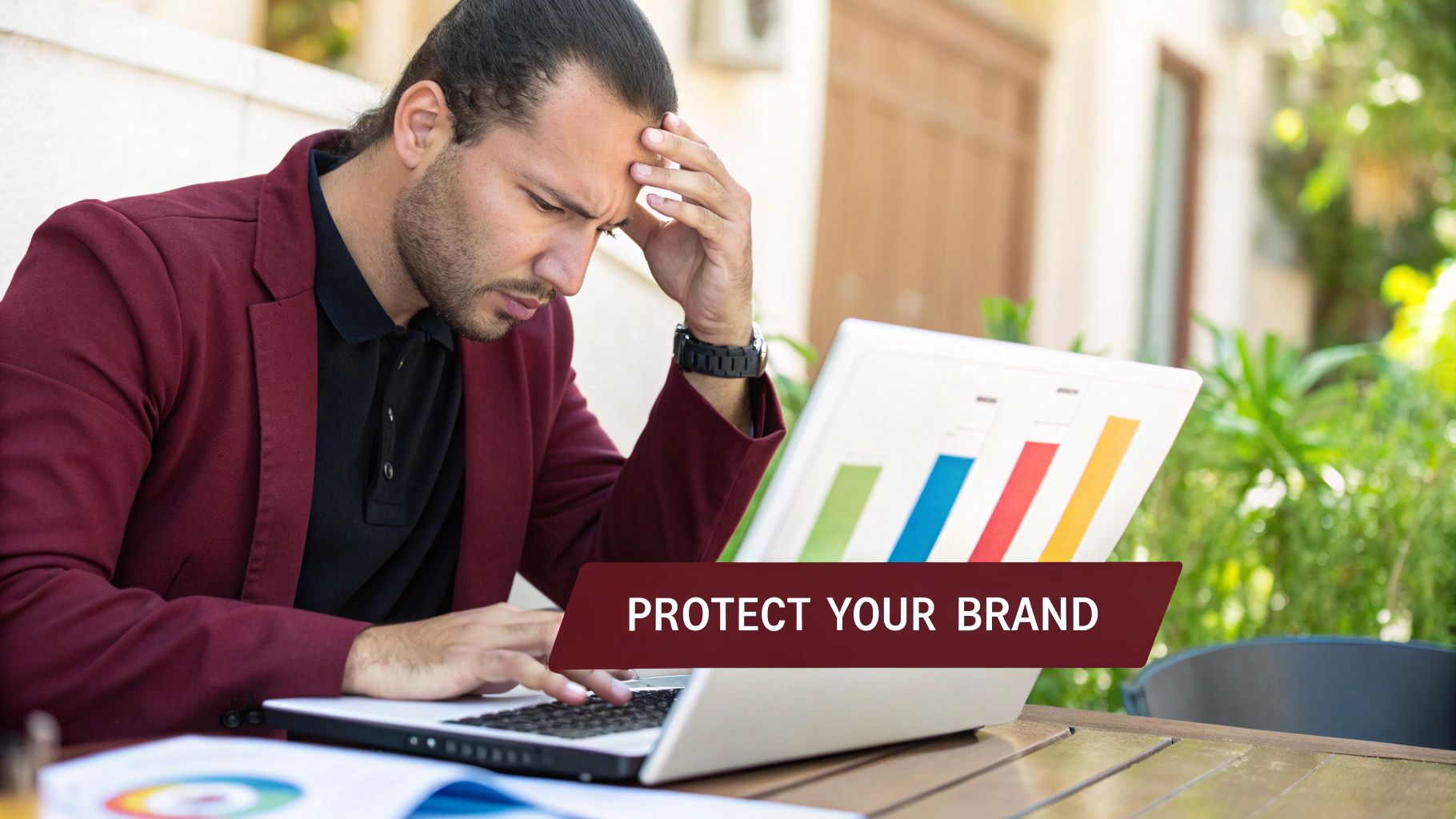
Building a successful brand on Amazon is a huge accomplishment. The last thing you want is for someone else to ruin it. This is why Amazon introduced brand gating. It’s their way of helping you protect your turf from counterfeiters and shady sellers.
For brand owners, the benefits are immediate. Gating gives you control over your product listings, stopping random sellers from messing with your images, titles, or descriptions. No more waking up to find your carefully crafted listing hijacked with bogus information.
It’s a necessary defense against hijackers trying to sell cheap knockoffs under your brand name. Without it, a hot-selling product can quickly become a free-for-all, leading to price wars, terrible customer experiences, and a tarnished brand reputation.
Protect Your Brand and Your Bottom Line
When your brand is gated, you’re doing more than just stopping fakes. You’re also bringing stability to your pricing and your brand’s perception.
Here’s a quick rundown of how it helps:
- Prevents Price Erosion: By controlling who can sell your products, you sidestep the dreaded “race to the bottom” on price. No more constant undercutting that makes your products look cheap.
- Maintains Listing Quality: You and your authorized partners control the message. This ensures customers always see accurate, high-quality information that reflects your brand standards.
- Reduces Negative Reviews: Stop counterfeit products, and you stop the flood of one-star reviews from angry customers who received a fake. It’s that simple.
Think of Amazon brand gating as a non-negotiable security system for any serious private label brand. Creating a great product is only half the battle; protecting it is the other. If you’re just starting out, our guide on launching a private label on Amazon FBA walks you through those first steps.
The Power of Proactive Enforcement
Amazon’s AI-powered systems are constantly scanning and reportedly block 99% of suspected counterfeit listings before a customer sees them. This is the muscle behind the brand gating policy.
This level of control also changes the game for sellers on your listings. Only vetted, authorized sellers can get in, which naturally leads to more stable pricing and happier customers.
Of course, none of this works without a strong brand identity. You need a solid foundation to protect. For some great advice on building that foundation, check out these Small Business Branding Tips.
Getting your brand gated sends a clear message to Amazon and any potential hijacker: you’re serious about defending your intellectual property.
Prerequisites for a Gating Request
Before you think about submitting an Amazon brand gating request, you need to have a few things locked down. Amazon doesn’t just hand out this level of protection; you have to prove you’re a legitimate brand owner who’s already defending your turf.
You’d need a verified identity, a clean record, and proof you can be trusted. For brand gating, Amazon wants to see a similar documented track record of brand protection.
Your Non-Negotiable Checklist
Amazon has clear requirements, and skipping even one is a surefire way to get your request denied. Let’s break down what you absolutely must have in place.
First, you need an active, registered trademark with a government body like the USPTO in the United States. A “pending” trademark application won’t cut it; it has to be fully registered.
With that trademark, your next step is to enroll in Amazon Brand Registry (version 2.0 or higher). Brand Registry is the program that gives you the tools you’ll need to build your case for gating.
This infographic lays out the foundational steps.
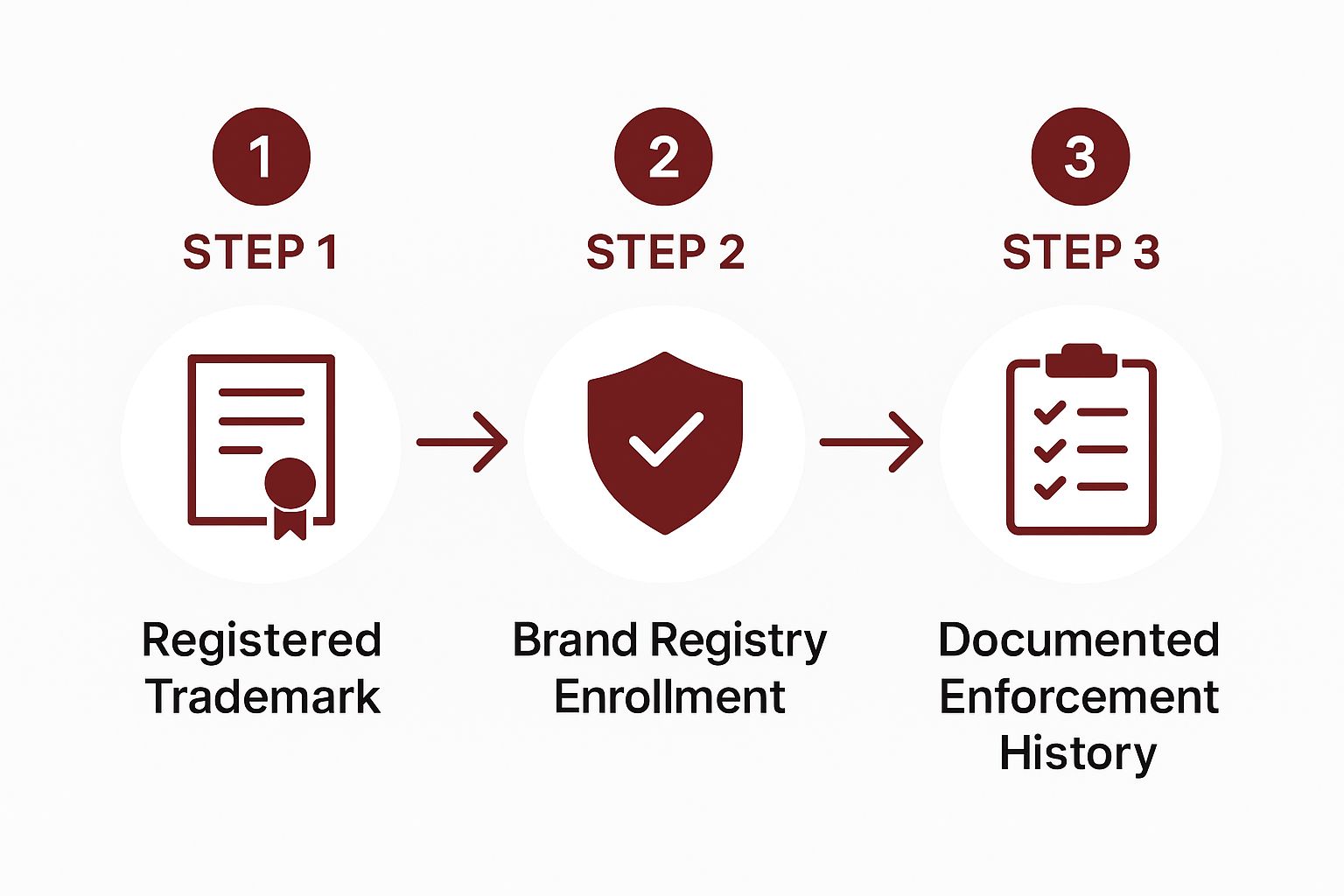
Prove Your Brand is Real
Next, you need to show Amazon your brand exists in the physical world. This means your logo must be permanently affixed to both your product and its packaging.
We’re not talking about stickers you can peel off. Amazon needs to see that your branding is an integral part of your product, not an afterthought.
Take high-quality photos that clearly show your logo on the product and on its retail box or packaging. These images are a critical part of your application, and they have to meet Amazon’s standards. For a full rundown, check our guide on the official Amazon image requirements in our guide.
Documented Enforcement History
This is where most sellers drop the ball. You must have a documented history of actively fighting counterfeiters and hijackers on the platform. Amazon wants to see that you’re already using their tools before they’ll give you more powerful ones.
Amazon rewards proactive brands. Before you ask for gating, you need to be consistently using the “Report a Violation” tool inside Brand Registry. Keep a detailed log of every case ID from these reports.
This enforcement history is your evidence. It proves that a problem exists, that you’re taking it seriously, and that the standard tools aren’t enough. When you submit your gating request, you’ll provide these case IDs. It shows Amazon you’re not just asking for protection; you’re demonstrating exactly why you need it. Without this paper trail, your request is just a claim with no proof.
How to Apply for Amazon Brand Gating: Step-by-Step

Getting your brand gated isn’t as simple as filling out a form. The real work starts long before you contact Seller Support. You have to build a rock-solid case that proves your brand is under attack and that standard protections aren’t cutting it.
The entire process boils down to one critical activity: proactively and consistently reporting counterfeiters.
Build Your Enforcement History
Your first job is to become a relentless defender of your brand. You’ll do this using the “Report a Violation” tool inside your Amazon Brand Registry dashboard. This is your command center for identifying and flagging sellers pushing fake versions of your products.
Every time you file a report, Amazon generates a case. Treat these Case IDs like gold. Keep a log of every single one, as this record is the ammunition for your gating request.
This isn’t a one-and-done deal. You’ll need to build this history over several weeks, maybe even a couple of months. A single report won’t move the needle; Amazon needs to see a persistent pattern of infringement that justifies gating your entire brand.
If you’re just starting out, building a brand worth protecting from day one is everything. Our guide on how to start an ecommerce business on Amazon walks you through creating that strong foundation.
Open the Gating Request Case
Once you’ve got a solid backlog of enforcement actions and a list of documented Case IDs, you’re ready to make the official request. But don’t go back to Brand Registry. Instead, you’ll open a new case directly from your Seller Central account.
Here’s how to do it:
- Go to Help: In Seller Central, click on “Help,” then “Get Support.”
- Describe Your Issue: Choose “Selling on Amazon” and explain what you need. Be direct. Something like, “Requesting brand gating due to repeated counterfeit issues” works well.
- Provide All the Details: When you write the case, keep it concise and professional. State your goal clearly and give them all the information they need right away to avoid back-and-forth with support reps.
What to Include in Your Case
The message you send is everything. A vague or incomplete request will be shut down almost instantly. You need to present a clear, evidence-backed argument that makes it a no-brainer for the support agent to approve your request.
Feel free to adapt this template:
Subject: Request for Brand Gating – [Your Brand Name]
Hello Amazon Seller Performance Team,
We are formally requesting to have our brand, [Your Brand Name], gated on Amazon.
We have been dealing with persistent issues from counterfeit sellers on our listings. This is causing significant damage to our brand’s reputation and creating a poor experience for customers.
Brand Name: [Your Brand Name]
Brand Registry Case ID: [Your Brand Registry Enrollment Case ID, if you have it]We are requesting that the following ASINs be gated immediately:
- [ASIN 1]
- [ASIN 2]
- [ASIN 3]
As evidence of these ongoing counterfeit problems, please refer to the following Case IDs from our recent infringement reports filed through Brand Registry:
- [Case ID 1]
- [Case ID 2]
- [Case ID 3]
- [Case ID 4]
- (List as many relevant Case IDs as you have)
Thank you for your assistance in protecting our brand and Amazon’s customers.
Sincerely,
[Your Name]
[Your Seller Name]
After you send the case, save the new case number and keep an eye on your Case Log for updates. Be ready to provide more info if they ask for it, but this structured approach gives you the best possible shot at a fast, successful outcome.
Advanced Tools for a Stronger Gating Case
Simply asking for Amazon brand gating often isn’t enough. You have to prove to Amazon that you’re actively protecting your own brand. Enrolling in Amazon’s other brand protection programs is the clearest signal you can send.
A basic gating request is like asking your landlord to put a new lock on the door. Enrolling in these programs is like installing your own high-tech security system with cameras and alarms. It shows Amazon you’re serious and makes them far more likely to grant your request.
Amazon Transparency Program
The Amazon Transparency program is one of the best ways to stop counterfeiters at the warehouse door. When you’re in the program, you put a unique, scannable QR code on every single unit you make.
When your products get to an Amazon fulfillment center, staff scan that code. If it’s missing or doesn’t scan correctly, the item is immediately flagged as a potential fake and pulled from inventory. It never even gets a chance to reach a customer. For Amazon, this is undeniable proof that you’re committed to authenticating your supply chain.
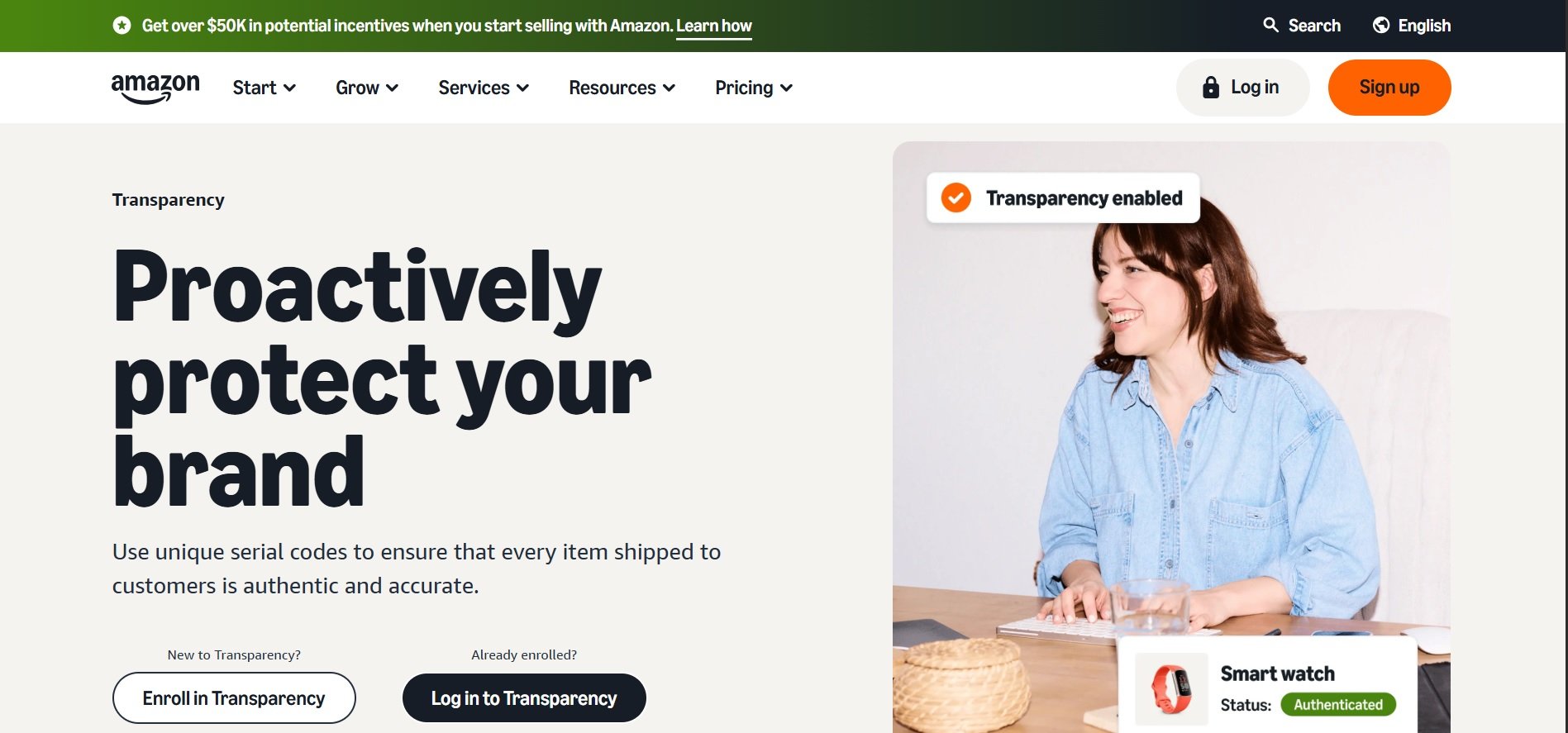
Project Zero
If you’re already fighting fakes, Project Zero is your heavy artillery. This program gives you the power to remove counterfeit listings yourself, no more opening cases and waiting weeks for an Amazon investigator.
Project Zero combines Amazon’s automated protections with your own self-service removal tool. Being accepted into this program means Amazon already trusts your ability to spot fakes, which gives your brand gating request a massive credibility boost. It’s a powerful endorsement that you’re a reliable partner in keeping the marketplace clean.
To qualify for Project Zero, your brand must meet certain criteria:
A) Your brand should be included in the Amazon Brand Registry and possess a government-registered trademark.
B) Additionally, you must:
- Own the trademark rights.
- Have an Amazon account with access to the Brand Registry.
- Have submitted infringement reports with at least a 90% acceptance rate over the past six months.
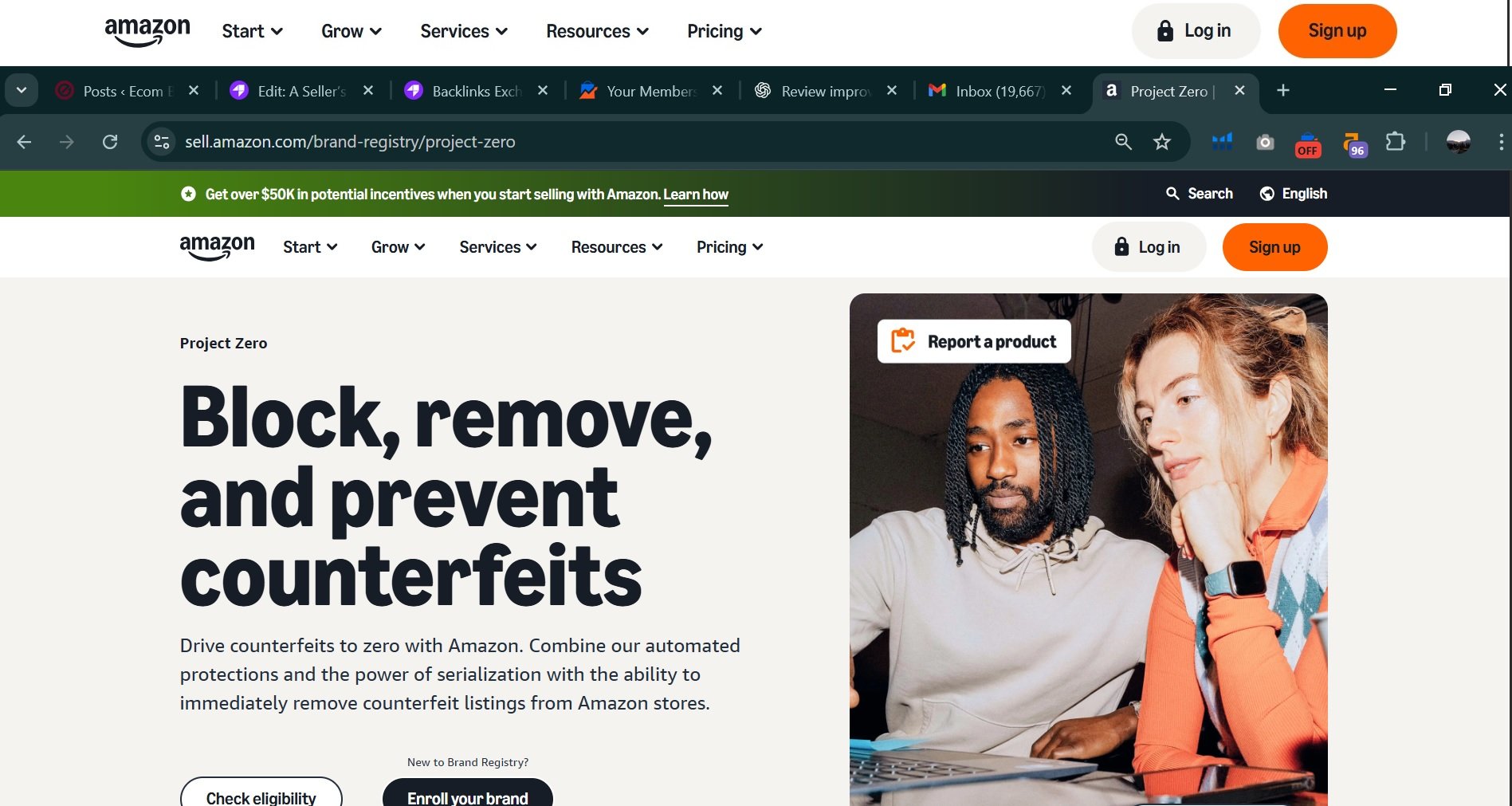
IP Accelerator
What if you’re a newer brand still waiting on a trademark? The IP Accelerator program is your shortcut. Amazon created it to help emerging brands get access to Brand Registry’s tools much faster by connecting you with a network of trusted IP law firms.
Once you file your trademark application through one of these firms, Amazon grants you early access to Brand Registry and its protection features while the official registration is pending. This is huge because it lets you start building an enforcement history months, or even years, sooner.
These programs all work together to create a layered defense for your brand. Brand Registry and gating are your first line of defense. Programs like Transparency add another layer by authenticating every unit. Finally, Project Zero lets you actively police your own listings. You can dive deeper into how these tools create a protective shield on the SequenceCommerce.com brand protection guide. When you use these tools, you’re not just asking for help; you’re showing Amazon you’re already an expert at helping yourself.
Common Gating Rejection Reasons and How to Fix Them
So, you submitted your brand gating request and… it got denied. It feels like hitting a brick wall, but don’t panic. This happens all the time, and it’s almost always a fixable problem.
More often than not, a rejection comes down to one simple thing: you haven’t convinced Amazon that your brand is actually under siege. From their perspective, why would they put up walls around a brand that isn’t facing a real, documented threat from counterfeiters? A single report of a hijacker just won’t cut it.
Insufficient Evidence of Infringement
The number one reason for rejection is a weak enforcement history. Amazon needs to see a clear and persistent pattern of infringement before they’ll take action. This usually boils down to two issues:
- Not Enough Reports: You’ve only reported a handful of shady sellers. Amazon is looking for a consistent, ongoing effort to police your listings.
- Poorly Detailed Reports: Your infringement claims were vague or lacked proof. Simply stating “this product is a fake” is an instant dead end.
The fix? Get methodical. Start conducting regular test buys from any seller you suspect is selling counterfeits. Once the item arrives, become a detective. Take high-quality photos that clearly highlight every difference between the fake and your genuine product. Document it all, from cheap packaging and blurry logos to shoddy materials. Build a case file for every single violator.
Key Takeaway: Your goal is to create an undeniable paper trail of counterfeit activity. Nothing persuades Amazon more than a long history of detailed, successful infringement reports.
Applying for the Wrong ASINs
Another common mistake is asking Amazon to gate ASINs that have a spotless record. If a specific product has never had a hijacker or a counterfeit report filed against it, Amazon sees no reason to lock it down.
Focus your firepower where the fight is actually happening. Start by prioritizing your best-selling products or the ASINs that counterfeiters seem to target most. Once you’ve successfully gated your most vulnerable products, you can think about expanding protection to other items in your catalog if needed.
If repeated gating failures are causing bigger problems with your account health, it’s smart to know what to do in a worst-case scenario. You can learn more about how to handle an Amazon account suspension if things ever get to that point.
When you do resubmit your request, don’t just send the same case file back to Amazon. Take the rejection as feedback. Strengthen your case with more test buys, add more detailed reports, and rewrite your submission to be as clear and convincing as possible.
How to Remove Unauthorized Resellers (When Gating Alone Isn’t Enough)
Amazon Brand Gating is one of the strongest ways to protect listings from unauthorized sellers, but it doesn’t always work as expected. Amazon often rejects brand gating requests, especially for brands that can’t provide strong proof of IP ownership or consistent distribution control.
Even after approval, gating may not cover every ASIN, allowing a few listings to stay open. In such cases, determined resellers can still find loopholes to list products through older ASINs or alternate conditions like “Used.” This often leads to price erosion, poor customer experience, and frustration among authorized partners.
This section outlines a structured approach brands can follow when they’ve decided it’s time to actively remove unauthorized resellers.
1. Get full buy-in from leadership
The hardest step for most brands isn’t legal or technical. It’s cultural. Leadership teams often hesitate because they worry about distributor backlash or short-term revenue loss.
But half-measures don’t work. If you’re serious about controlling your brand on Amazon, you have to commit to a long-term enforcement strategy that may cause short-term bumps but usually pays off with higher margins and stronger pricing stability.
2. Rewrite distributor agreements
The next step is tightening your agreements with authorized distributors. Contracts need to explicitly state what is and isn’t allowed regarding Amazon sales.
The most effective clause we’ve seen: requiring any buyer who purchases five or more units of a branded product to provide documentation certifying they won’t resell on Amazon.
Following through until every distributor signs is non-negotiable. A single weak link can feed inventory to dozens of resellers.
3. Contact unauthorized sellers directly
Cease-and-desist letters are often ignored. Experienced resellers know these letters rarely escalate.
What works better is escalating the tone immediately, making it clear that a formal IP complaint will be filed with both Amazon and its Counterfeit Crimes Unit (CCU) if activity continues.
In testing, this approach was about 3x more effective than traditional cease-and-desist notices.
4. Identify rogue distributors
Sometimes the issue isn’t unknown resellers, it’s your own supply chain. Brands have discovered Amazon Retail (1P) selling their products even when they hadn’t shipped to them directly in months.
The approach is straightforward: assign unique identifiers to the shipments sent to each distributor. Then buy a product from an unauthorized reseller, you can examine the identifier to determine which distributor is supplying products to unapproved sellers.
That’s how one of our brand caught a distributor secretly funneling inventory to Amazon.
5. Consider the Transparency Program (as a last resort)
Amazon’s Transparency Program is designed for counterfeit prevention, not reseller management. But in cases where all other methods fail, it can still help by requiring unique codes to be scanned before inventory is accepted.
6. Results from a real case
In one campaign using the exact steps above, a brand reduced dozens of unauthorized sellers down to just three authorized resellers.
- Buy Box price increased by 60%
- Monthly revenue grew 35% year-over-year
- Margin improved by 30% significantly due to price stabilization
Your Brand Gating Questions Answered
Even when the process seems straightforward, a few common questions always pop up about Amazon brand gating. Let’s tackle some of the ones we hear most often.
How much does brand gating cost?
Applying for brand gating itself is completely free. Amazon won’t charge you to submit your request.
But that doesn’t mean it costs nothing to get there. The biggest hurdle is getting a registered trademark, which involves government and legal fees that can run from a few hundred to a couple of thousand dollars.
Plus, if you decide to use programs like Amazon Transparency to bulletproof your application, you’ll pay a small fee, usually a few cents, for each unique code you generate. The most significant investment, though, isn’t always money. It’s the time you’ll spend monitoring your listings and meticulously documenting every violation you find.
Can I ungate my brand for authorized resellers?
Yes, absolutely. This is one of the best parts of the program. Once your brand is gated, you’re not slamming the door on legitimate partners forever. You get to create a “whitelist” of trusted resellers.
All you have to do is provide Amazon with the Seller IDs of your authorized partners. This gives them a special pass to sell your products while keeping every unauthorized seller locked out. It’s a flexible system that lets you build a real distribution network on Amazon without leaving your brand vulnerable.
Is brand gating the same as brand registry?
Nope, they’re different, but one definitely leads to the other. Think of it like this:
Amazon Brand Registry is the exclusive club, and brand gating is one of the most powerful perks you get for being a member.
Just enrolling in Brand Registry doesn’t automatically gate your brand. That’s a common misconception. Signing up is the mandatory first step. It gives you the tools you need, like the “Report a Violation” feature, which is your primary weapon for building a case. From there, you have to actively use those tools to prove to Amazon that you need gating and then formally request it.





